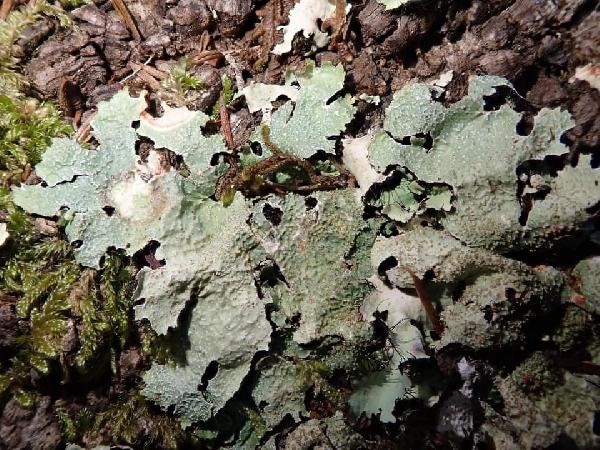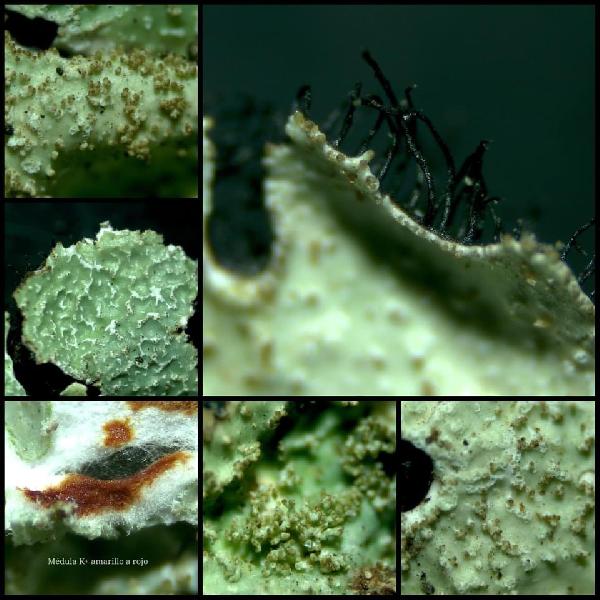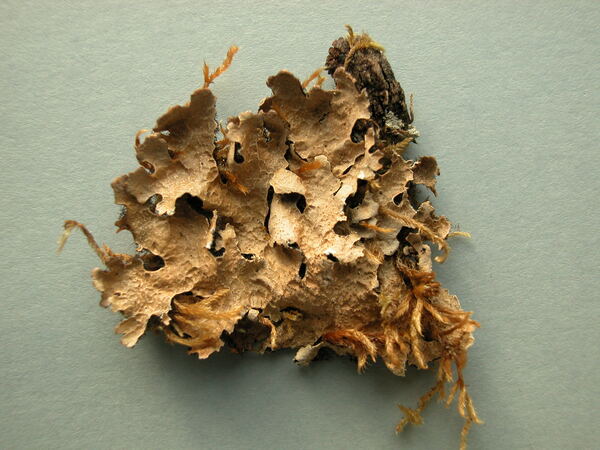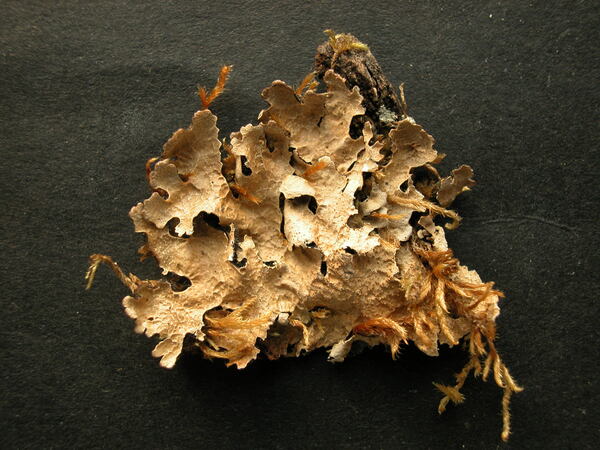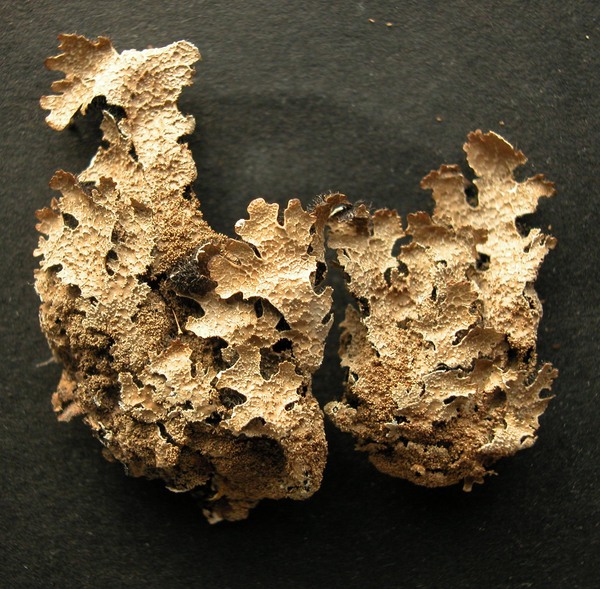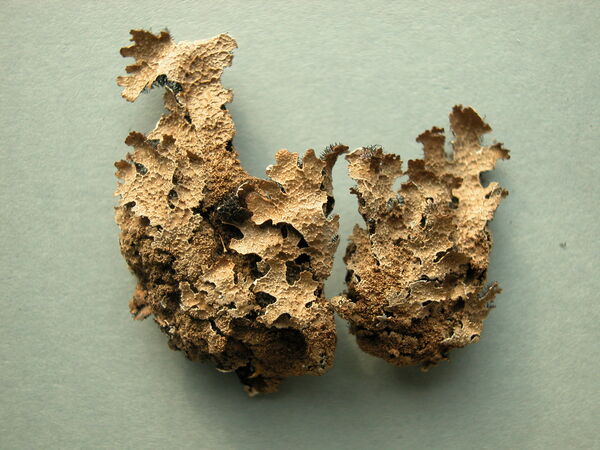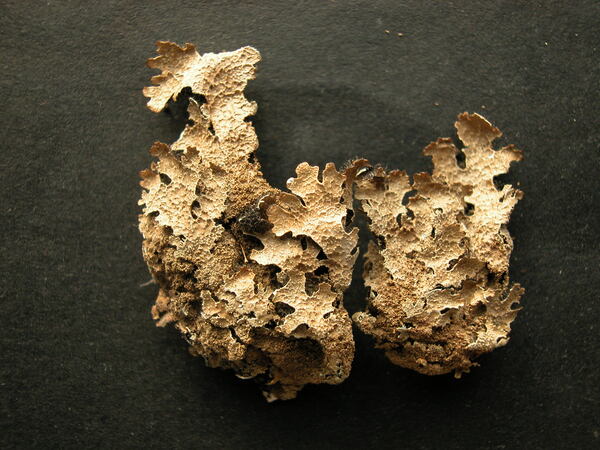Parmelia serrana A. Crespo, M.C. Molina & D. Hawksw.
in Molina & al., Lichenologist, 36: 48, 2004.
Synonyms:
Distribution: N - Frl (LD-1256370). C - Tosc (Castellani & al. 2021).
Description: Thallus foliose, heteromerous, dorsiventral, adnate to rather loosely attached, forming 3-7(-15) cm wide, regular rosettes. Lobes relatively short and broad, 2-4(-6) mm wide, often overlapping, sublinear, with rounded to sublinear apices. Upper surface pale greenish-grey to whitish grey, weakly ridged, shiny mainly near the margins, sometimes dull and reticulately cracked, epruinose or rarely weakly pruinose at margins, with a conspicuous network of whitish, at first punctiform but soon linear, laminal and marginal pseudocyphellae, and with cylindrical, laminal or marginal, simple or branched isidia that are up to 0.2-0.5(-0.8) mm tall and 0.05-0.1 mm wide, and mainly concentrated in the central part of thallus and on the ridges. Lower surface black, with simple or sparingly furcate (never squarrose), 0.2-1.5 mm long rhizines. Upper cortex paraplectenchymatous, of 2-6 layers of densely packed cells, with a usually non-pored epicortex, the cell walls with isolichenan; medulla white; algal layer continuous; lower cortex paraplectenchymatous, thinner than upper cortex. Apothecia rather frequent, lecanorine, subpedicellate, concave, 1-4 mm across, with a brown disc and an often isidiate thalline margin. Epithecium brownish; hymenium and hypothecium colourless. Asci 8-spored, clavate, Lecanora-type. Ascospores 1-celled, hyaline, broadly ellipsoid, 16-18 x 11.5-13 μm. Pycnidia black. Conidia cylindrical to bacilliform 5-6 x c. 1 µm. Photobiont chlorococcoid. Spot tests: upper cortex K+ yellow (but often slowly turning dirty red due to medullary substances), C-, KC-, P-; medulla K+ yellow turning dirty red, C-, KC-, P+ orange-red. Chemistry: upper cortex with atranorin; medulla with salazinic acid (major), consalazinic acid (minor), plus often traces of protocetraric and rarely lobaric acids, and fatty acids (lichesterinic, protolichesterinic, nephrosterinic and isonephrosterinic acids).
Note: according to Crespo & al. (2020), this is by far the most frequent epilithic species of the P. saxatilis-aggregate in the Iberian Peninsula; it seems to be widespread in southern Europe, especially in areas with a subcontinental climate. Its Italian distribution is very poorly known, and most records are probably hidden among those of P. saxatilis s.lat. The samples from Friuli, collected by Hruby at Raibl near Tarvisio, were identified by G. Thor.
Growth form: Foliose, broad lobed
Substrata: bark and rocks
Photobiont: green algae other than Trentepohlia
Reproductive strategy: mainly asexual, by isidia, or isidia-like structures (e.g. schizidia)
Commonnes-rarity: (info)
Alpine belt: absent
Subalpine belt: absent
Oromediterranean belt: absent
Montane belt: very rare
Submediterranean belt: absent
Padanian area: absent
Humid submediterranean belt: extremely rare
Humid mediterranean belt: very rare
Dry mediterranean belt: absent

Predictive model
Herbarium samples
Growth form: Foliose, broad lobed
Substrata: bark and rocks
Photobiont: green algae other than Trentepohlia
Reproductive strategy: mainly asexual, by isidia, or isidia-like structures (e.g. schizidia)
Commonnes-rarity: (info)
Alpine belt: absent
Subalpine belt: absent
Oromediterranean belt: absent
Montane belt: very rare
Submediterranean belt: absent
Padanian area: absent
Humid submediterranean belt: extremely rare
Humid mediterranean belt: very rare
Dry mediterranean belt: absent

Predictive model
| Herbarium samples |
 Index Fungorum
Index Fungorum
 GBIF
GBIF
